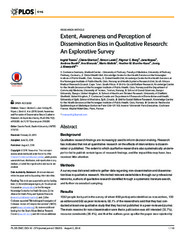Extent, Awareness and Perception of Dissemination Bias in Qualitative Research: An Explorative Survey
Permanent link
https://hdl.handle.net/10037/9795Date
2016-08-03Type
Journal articleTidsskriftartikkel
Peer reviewed
Author
Toews, Ingrid; Glenton, Claire; Lewin, Simon; Berg, Rigmor C.; Noyes, Jane; Booth, Andrew; Marusic, Ana; Malicki, Mario; Munthe-Kaas, Heather M.; Meerpohl, Joerg J.Abstract
Background
Qualitative research findings are increasingly used to inform decision-making. Research has indicated that not all quantitative research on the effects of interventions is disseminated or published. The extent to which qualitative researchers also systematically underreport or fail to publish certain types of research findings, and the impact this may have, has received little attention.
Methods
A survey was delivered online to gather data regarding non-dissemination and dissemination bias in qualitative research. We invited relevant stakeholders through our professional networks, authors of qualitative research identified through a systematic literature search, and further via snowball sampling.
Results
1032 people took part in the survey of whom 859 participants identified as researchers, 133 as editors and 682 as peer reviewers. 68.1% of the researchers said that they had conducted at least one qualitative study that they had not published in a peer-reviewed journal. The main reasons for non-dissemination were that a publication was still intended (35.7%), resource constraints (35.4%), and that the authors gave up after the paper was rejected by one or more journals (32.5%). A majority of the editors and peer reviewers “(strongly) agreed” that the main reasons for rejecting a manuscript of a qualitative study were inadequate study quality (59.5%; 68.5%) and inadequate reporting quality (59.1%; 57.5%). Of 800 respondents, 83.1% “(strongly) agreed” that non-dissemination and possible resulting dissemination bias might undermine the willingness of funders to support qualitative research. 72.6% and 71.2%, respectively, “(strongly) agreed” that non-dissemination might lead to inappropriate health policy and health care.
Conclusions
The proportion of non-dissemination in qualitative research is substantial. Researchers, editors and peer reviewers play an important role in this. Non-dissemination and resulting dissemination bias may impact on health care research, practice and policy. More detailed investigations on patterns and causes of the non-dissemination of qualitative research are needed.
Qualitative research findings are increasingly used to inform decision-making. Research has indicated that not all quantitative research on the effects of interventions is disseminated or published. The extent to which qualitative researchers also systematically underreport or fail to publish certain types of research findings, and the impact this may have, has received little attention.
Methods
A survey was delivered online to gather data regarding non-dissemination and dissemination bias in qualitative research. We invited relevant stakeholders through our professional networks, authors of qualitative research identified through a systematic literature search, and further via snowball sampling.
Results
1032 people took part in the survey of whom 859 participants identified as researchers, 133 as editors and 682 as peer reviewers. 68.1% of the researchers said that they had conducted at least one qualitative study that they had not published in a peer-reviewed journal. The main reasons for non-dissemination were that a publication was still intended (35.7%), resource constraints (35.4%), and that the authors gave up after the paper was rejected by one or more journals (32.5%). A majority of the editors and peer reviewers “(strongly) agreed” that the main reasons for rejecting a manuscript of a qualitative study were inadequate study quality (59.5%; 68.5%) and inadequate reporting quality (59.1%; 57.5%). Of 800 respondents, 83.1% “(strongly) agreed” that non-dissemination and possible resulting dissemination bias might undermine the willingness of funders to support qualitative research. 72.6% and 71.2%, respectively, “(strongly) agreed” that non-dissemination might lead to inappropriate health policy and health care.
Conclusions
The proportion of non-dissemination in qualitative research is substantial. Researchers, editors and peer reviewers play an important role in this. Non-dissemination and resulting dissemination bias may impact on health care research, practice and policy. More detailed investigations on patterns and causes of the non-dissemination of qualitative research are needed.
Description
Publisher's version, source: http://doi.org/10.1371/journal.pone.0159290.


 English
English norsk
norsk